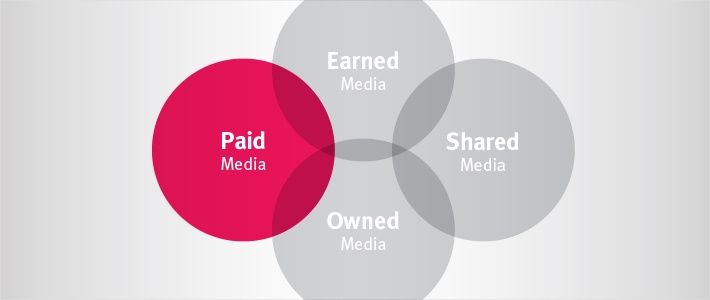In a previous post we discussed the merits of unbundling, repurposing and amplifying content that often starts life in print form or buried within a PDF. We now want to dig a little deeper into the amplification – and in doing so reach for the PESO model. PESO? It stands for:
- Paid
- Earned
- Social; and
- Owned
Conceptually, PESO is a useful framework on which to plan, execute and measure efforts to push out content to relevant audiences. Subsequent posts will discuss earned, social and owned strategies but first up it’s ‘P’ for paid.
Paid in this context is not glossy TV, press or outdoor advertising. Rather it is the more prosaic – but potentially more effective – tools of the digital trade. These include:
- Search engine advertising such as Google AdWords
- Social media promotion such as Sponsored Tweets, Facebook Sponsored Posts and LinkedIn Ads
- Content recommendation engines such as Outbrain and Taboola
The list might also feature targeted on-site advertising and even native advertising and sponsored content. But what unites these seemingly disparate tools are four key features. All give the would-be content-amplifier the ability to:
1. Tightly target key audience(s)
Scale is everything when it comes to digital and the scale of the biggest platforms of all – search and social – means advertisers can target an audience with precision. Search advertising is primarily concerned with self-selection: matching user queries with pertinent information. Google’s AdWords auctions, for example, are designed to reward relevancy. The ability to match need with solution, question with answer, invariably means that a longer search query – a longtail keyword, to borrow the terminology of search engine marketing – works far better than a shorter, more generic search query.
For the social networks, meanwhile, targeting is about matching content to audience via demographic and interest parameters. On LinkedIn, for example, filters include industry sector, company size and location. On Twitter, advertisers can create influencer lists and then display Promoted Posts just to those people. And on Facebook, among other filters, advertisers can target by job title.
2. Test and iterate on a small budget
Most of these tools come with A/B testing built in. That means advertisers can develop more than one creative approach and soon see which is working best. Replace the weaker approach with a third set of creatives and aim to displace the stronger approach. Keep fine-tuning for even better results. And because the economics of digital platform advertising – tens and hundreds of pounds rather than thousands and tens of thousands of pounds – there isn’t really a barrier to entry for those who wish to start in experimentation-mode.
3. Gain a better understanding of audience
Many of these tools are self-service which gives the advertiser an opportunity to interrogate platform databases for themselves. Within those databases is a wealth of information – demographic, interest areas, behaviours – from which to get under the skin of key audiences and understand how they interact with the social network or search engine. This learning then can be applied to non-paying activity on social networks and search engines.
4. Improve organic performance
A tightly targeted, well-managed digital advertising campaign – matched by content that is interesting and relevant – is likely to have the desired outcomes: more page views and engagement. It will also have a benign affect on organic activity, generating social media shares and mentions elsewhere. And those mentions will most likely include an embedded link back to the destination site or article which will, in turn, improve the site’s search engine rankings.


